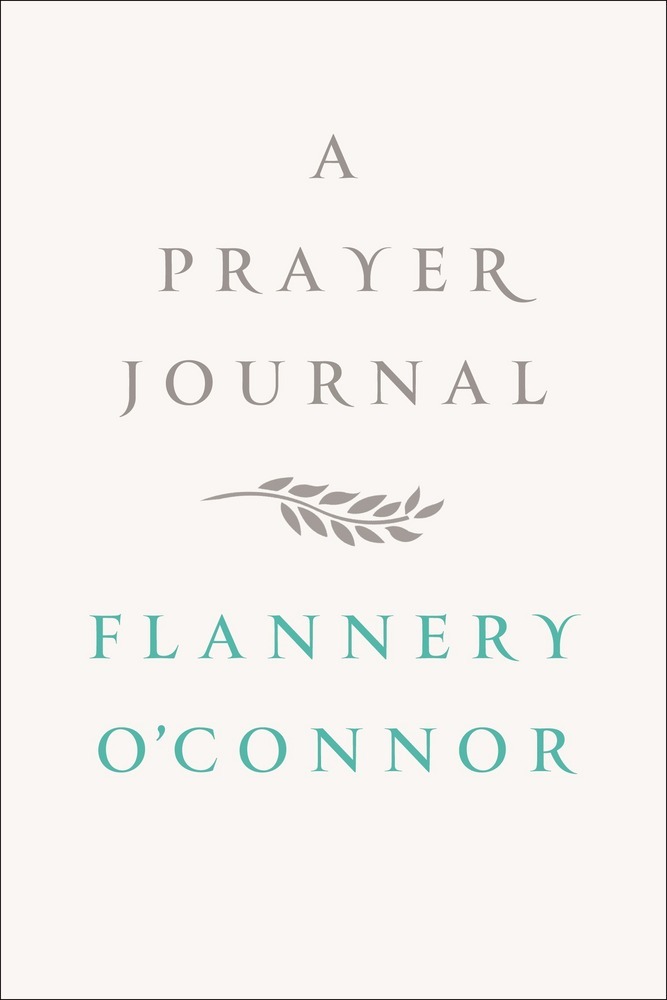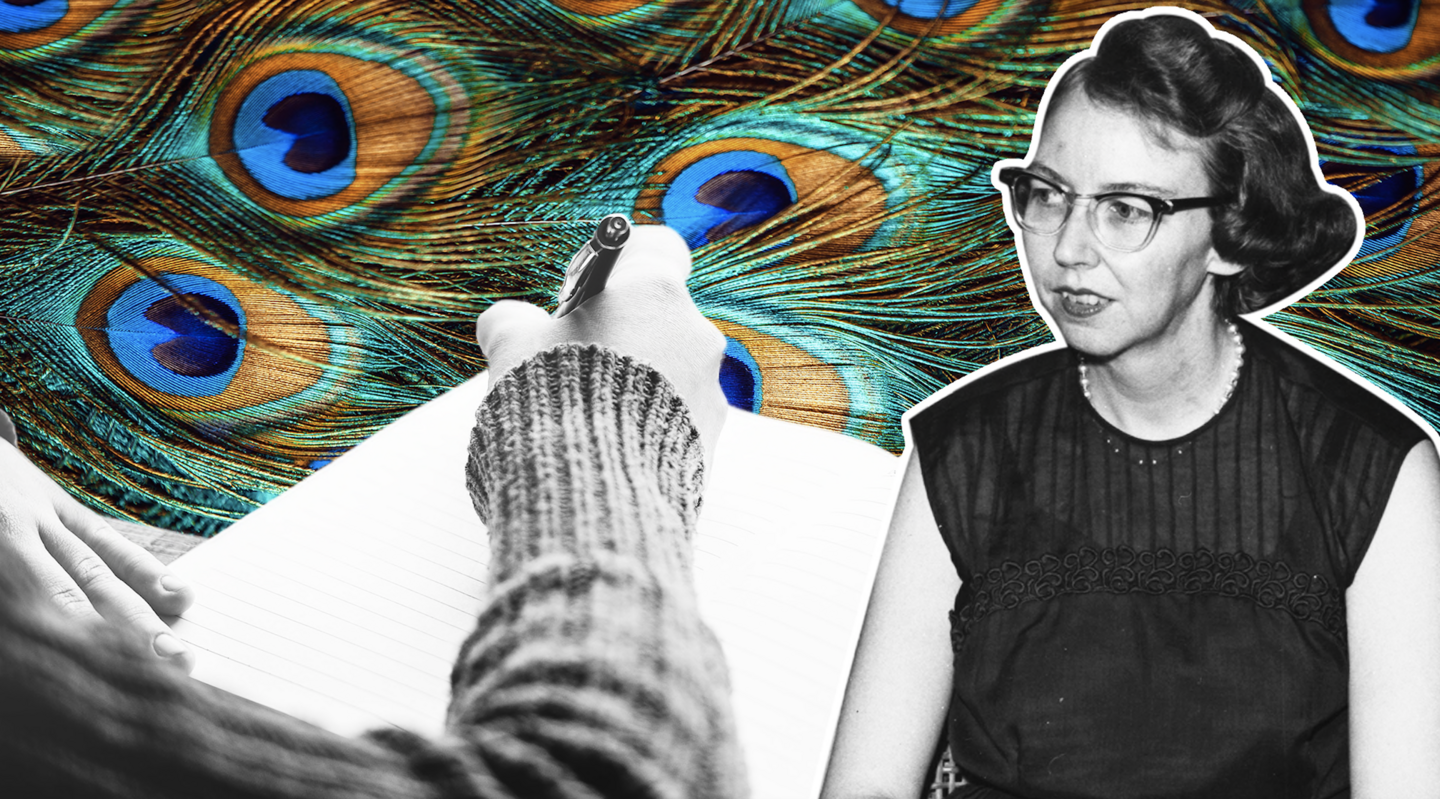“Dear God, I cannot love Thee the way I want to. You are the slim crescent of a moon that I see and my self is the earth’s shadow that keeps me from seeing all the moon. The crescent is very beautiful and perhaps that is all one like I am should or could see; but what I am afraid of, dear God, is that my self shadow will grow so large that I block the whole moon, and that I will judge myself by the shadow that is nothing. I do not know you God because I am in the way. Please help me to push myself aside.”
Flannery O’Connor wrote these words in January of 1946 when she was an MFA student at the Iowa Writers’ Workshop. They capture the spiritual agon that she was engaged in as she struggled to discover the connection between her vocation as a writer and her vocation as a Catholic. Found among her papers by scholar William Sessions, a friend of hers, O’Connor’s A Prayer Journal was published to great acclaim in 2013 as it gave readers a glimpse into the baptism by fire she endured before emerging as America’s finest Catholic writer of the 20th century. Five years later, Prayer Journal continues to appeal to readers who value her work as it teaches us not only about the author, but also about ourselves as people in pursuit of twin vocations, the professional and the spiritual, and the challenges of reconciling the two.
I recently revisited the Prayer Journal and found it to be as poignant and profound as when I first read it. What strikes me on this reading is the way writing the journal helped O’Connor to grow not only in her faith but also in her art, enabling a fledgling writer to experiment with and discover her literary vocation and voice. Most of the entries in the Prayer Journal, beginning in Jan. 1946 and concluding in Sept. 1947, take the form of letters. This is a genre O'Connor would master after she was diagnosed with lupus and exiled to her mother’s farm, Andalusia, in rural Georgia for the last 13 years of her life. During this period letters would become her primary means of communication with the outside world. These mature letters, wherein the full range of O’Connor’s literary gifts are on display, were eventually published as The Habit of Being, one of the finest collections of correspondence ever produced by a writer.
Letter writing is a genre O'Connor would master after she was diagnosed with lupus and exiled to her mother’s farm.
O’Connor enjoyed letter-writing from an early age and took some pride in her skill. In an earlier journal O’Connor kept in college, humorously (mis)titled Higher Mathematics and recently found among her papers, she writes: “My epistolary powers enthrall me. It is a pity I can’t receive my own letters. If they produce as much whole-hearted approval at their destination as they do at their source, they should indeed be able to keep my memory alive—and healthy” (Jan. 22, 1944). These early letters are, in some ways, apprentice pieces, preparation for the mature letters she would write and also served as practice for her fiction.
The epistolary element of the Prayer Journal, in particular, provided her with the opportunity to write letters of a different nature from any she had written before. For these are letters to God and, as such, opened up an avenue for communication about matters of the soul, making them more frank and intimate than any she might have penned to ordinary people. The letters functioned in a variety of ways, but for present purposes I would like to focus on three.
First, they gave her the chance to explore her most private thoughts and feelings without exposing herself or her work to judgment or censure—something she endured on a regular basis at the Iowa workshop. Unlike her fiction, which she hoped would be read by many people, her letters to God would, like prayer, remain sealed and secret. This gave O’Connor the freedom to address her greatest spiritual challenges and her besetting sins. Among these are the twin torments of fear and desire. As the opening excerpt suggests, one of her primary fears is that of the self and its relentless demands. She also fears the tyranny of her intellect, the loss of her faith and literary and spiritual mediocrity. But more than fear, these letters are the record of desire. O’Connor writes at one point that supplication is the only kind of prayer she is good at. She desires many things, but what she wants most of all is to be a good writer:
Dear God, I am so discouraged about my work. . . . Please help me dear God to be a good writer and to get something else accepted. That is so far from what I deserve, of course, that I am naturally struck with the nerve of it.
Her desire for literary accomplishment and fame exists in tension with her fear of her own pride and egotism. She knows she is smart and is very much taken with her own intellect. In another letter to God, after making a joke in the midst of her prayer (her sense of humor forever getting the best of her, both in her stories and her letters), she confesses, “I do not mean to be clever . . . although I do mean to be clever on 2nd thought and like to be clever and want to be considered so.” Though she knows the danger of intellectual pride—like the young girl in her story “The Temple of the Holy Ghost,” whose character is essentially a self-portrait—she cannot help but indulge in it and worries about its spiritual consequences. Thus, desire and fear grapple with one another as O’Connor’s psychomachia rages on the page, and even as the contest takes place, she becomes a more practiced writer.

A second purpose served by the letters is that they filled a void at a time in O’Connor’s life when she found herself a stranger in a strange land, living and writing among people who did not share her faith. In her second entry in the Prayer Journal she writes: “I dread, oh Lord, losing my faith. My mind is not strong. It is a prey to all sorts of intellectual quackery.” When O’Connor went to Iowa, she was, for the first time in her life, surrounded almost entirely by people who did not share her beliefs. Far from her devout mother and her large extended Catholic family, O’Connor struggled with doubt and feared she was not strong enough in her faith to withstand the assault made on it by her writer colleagues and the secular university culture. Her letters to God provided her with a new avenue of prayer—something she desperately needed because, in her words, “I have been saying [the traditional prayers I have said all my life] but not feeling them.” Engaging in this colloquy with God, however, she confided, “I can feel the warmth of love heating me when I think & write this to You.” God became a familiar, friend and confidant, rather than a distant impersonal force approachable only through sanctioned means. O’Connor was charting unknown territory in inventing these prayers—something Catholics of her era were not encouraged to do—and for a while, at least, she reveled in the experience.
A third opportunity the letters gave her was the rare chance to write from the first-person perspective, something she did not do in her fiction, and to discover how to create a persona. While it is true that O’Connor attempted to be her unvarnished self in these letters, she was also creating a construct of herself. As Sessions notes in his introduction, these entries are spontaneous, but they are also revised, betraying the element of conscious craft in her writing. They are literary experiments—something O’Connor acknowledges at various times. About halfway through the journal, she writes: “I have decided this is not much as a direct medium of prayer. Prayer is not even as premeditated as this—it is of the moment & this is too slow for the moment.” In the final entry, she admits that the experiment in communing with God has not worked: “My thoughts are so far away from God. He might as well have not made me. And the feeling I egg up writing here lasts approximately a half hour and seems a sham.” The very quality of this form of prayer she enjoyed so much at first—the feeling it engendered—she now begins to distrust. In the battle between her intellect and her heart, her intellect gets the upper hand.
While O’Connor may have viewed the prayer experiment as a failure, it was in reality a great success. In creating and inhabiting the varying personae she created—Angry Flannery, Frustrated Flannery, Remorseful Flannery, Grateful Flannery—she was engaging in what Henry James once called “The Histrionic Imagination,” effectively training herself for her work as a fiction writer. She was practicing empathy—a virtue that did not come easily to O’Connor. The cultivation of the capacity to see and describe the world from these varying perspectives would enable her to create characters who were as different from herself as chickens from peacocks. It would enable her to become the racist Ruby Turpin she depicts in “Revelation”; the foul-mouthed, tattoo-obsessed O.E. Parker in “Parker’s Back”; a selfish old grandmother and a sensitive serial killer in “A Good Man is Hard to Find.” These acts of imagination make O’Connor’s writing essentially dramatic—in both A Prayer Journal and her fiction. Thomas Merton, on hearing of her death, compared her to Sophocles—the great dramatist—rather than another fiction writer, as she depicted the elemental human struggle between characters who were grand and yet ordinary, true-to-life and somehow larger-than-life.
Writing the Prayer Journal helped O’Connor to grow not only in her faith but also in her art.
The poet John Keats in one of his letters writes of the two great models of the artistic imagination in comparing what he calls “The Chameleon Poet” (represented by Shakespeare) and “The Egotistical Sublime” (the kind of poetry pioneered by Wordsworth). Keats aspired to the condition of the Chameleon Poet, envying Shakespeare’s ability to become his characters so thoroughly that he himself disappeared, but he had difficulty accomplishing it. Keats’s best poems are those that, like Wordsworth’s, focus on himself. But O’Connor was able to imaginatively occupy the condition of the other. And, paradoxically, she achieved this, in part, through her letters to God, which might seem to be exercises in the Egotistical Sublime but served, ultimately, to teach her how to transcend the self—or, alternately, to write about the self through her characters. “Is there no escape from ourselves? Into something bigger?” she asks in one of the journal entries. The answer provided by her fiction is yes.
In one of her later letters to a friend, O’Connor speaks about the first story she wrote at Iowa, “The Geranium,” a tale about an old southerner who goes to live in the alien environment of New York City and finds himself miserably homesick for the world he left behind. O’Connor admits that at the time she knew nothing about New York City, but she did know something about homesickness—and since she could not write about herself, the old man served as a kind of double for her. O’Connor wrote “The Geranium” around the same time she was writing her letters to God, and the imaginative work she did in composing them helped her to accomplish this.
After nearly two years, O’Connor abruptly stopped writing her journal. One reason for this is that it had served its purpose. It is instructive that the first words of the journal express her distrust of the self—“I do not know you, God, because I am in the way”—and the last words are these: “There is nothing left to say of me.” All that needed to be said of young Flannery O’Connor had been said—and it was time to turn her full attention to her characters, to pour her self into them and make them come alive.
The fact that O’Connor’s journal is a form of literary experimentation does not make it any less genuine. This is, after all, what writers do—find language that leads to a fuller apprehension of our inner and outer weather, as Robert Frost puts it, the ways in which the self is related to the physical world and spiritual cosmos we inhabit. She moves from the practice of praise, petition and thanksgiving to interrogation and self-castigation, employing a variety of voices and rhetorical modes to arrive at a better understanding of God, herself and her vocation as an artist.
Her letters to God led to self-revelation. O’Connor discovered aspects of herself she would rather not. This discovery gave her a sense of relief and permission to move on with her true work, the business of writing fiction. Prayer is what Catholics do, and O’Connor prayed in every way she could find—in church, by her bedside, in her journal and in her stories. All of these avenues gave her access to the God she so fervently sought and, blessedly, found.










